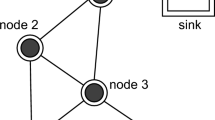Abstract
The APTEEN routing protocol has been widely used due to its practicability. But it exists the problems of uneven network energy consumption, premature death of some nodes and low effective coverage of the whole network. To solve these problems, this paper uses the genetic algorithm to optimize the APTEEN routing protocol. By adding residual energy, distance from node to base station, distance from node to geometric center of the whole network, node degree and other selection factors to cluster heads selection, the genetic algorithm is used to select cluster heads for the first time, and the second cluster heads selection based on density adaptive algorithm. Some nodes are selected to sleep according to the position and degree of nodes. The residual energy of cluster head, the distance between node and cluster head, and the number of cluster members are taken into account when nodes join clusters, and the GA-APTEEN routing protocol is obtained through the above optimization. The simulation results show that the GA-APTEEN improves the lifetime, coverage and robustness of the network, reduces the energy consumption of the overall network system and avoids the phenomenon of the hot zone of energy.
Access this chapter
Tax calculation will be finalised at checkout
Purchases are for personal use only
Similar content being viewed by others
References
Choi J, Jung S, Han Y, Chung T (2008) Advanced concentric-clustering routing scheme adapted to large-scale sensor networks. In: 2008 second international conference on sensor technologies and applications (sensorcomm 2008), Cap Esterel, pp 366–371
Ma J, Wang S, Meng C, Ge Y, Du J (2018) Hybrid energy-efficient APTEEN protocol based on ant colony algorithm in wireless sensor network. EURASIP J Wireless Commun Networking 102:1–13
Suhas More S, Nighot MK (2017) Optimization of wireless sensor networks using artificial intelligence and ant colony optimization for minimizing energy of network and increasing network lifetime. In: 2017 international conference on computing, communication, control and automation (ICCUBEA), Pune, pp 1–6
Omari M, Laroui S (2015) Simulation, comparison and analysis of wireless sensor networks protocols: LEACH, LEACH-C, LEACH-1R, and HEED. In: 2015 4th international conference on electrical engineering (ICEE), Boumerdes, pp 1–5
Guo P, Wang X, Han Y (2010) The enhanced genetic algorithms for the optimization design. In: 2010 3rd international conference on biomedical engineering and informatics, Yantai, pp 2990–2994
Mao X (2018) Study and application of adaptive density peak clustering. Jilin University (Chinese)
Tao LI, Hong-Wei GE, Shu-Zhi SU (2017) Density peaks clustering based on density adaptive distance. J Chin Comput Syst 38(6):1347–1352
Wen T, Zhang D, Guo Q, Song X (2014) Sleeping scheduling algorithm for redundant nodes in wireless sensor networks. J Commun 35(10):67–80 (Chinese)
Acknowledgements
Shubin Wang (wangshubin@imu.edu.cn) is the correspondent author and this work was supported by the National Natural Science Foundation of China (61761034), and the Natural Science Foundation of Inner Mongolia, China (2016MS0616).
Author information
Authors and Affiliations
Corresponding author
Editor information
Editors and Affiliations
Rights and permissions
Copyright information
© 2020 Springer Nature Singapore Pte Ltd.
About this paper
Cite this paper
Wang, M., Wang, S., Zhang, B. (2020). Optimization of APTEEN Routing Protocol for Wireless Sensor Networks Based on Genetic Algorithm. In: Liang, Q., Wang, W., Liu, X., Na, Z., Jia, M., Zhang, B. (eds) Communications, Signal Processing, and Systems. CSPS 2019. Lecture Notes in Electrical Engineering, vol 571. Springer, Singapore. https://doi.org/10.1007/978-981-13-9409-6_84
Download citation
DOI: https://doi.org/10.1007/978-981-13-9409-6_84
Published:
Publisher Name: Springer, Singapore
Print ISBN: 978-981-13-9408-9
Online ISBN: 978-981-13-9409-6
eBook Packages: EngineeringEngineering (R0)




